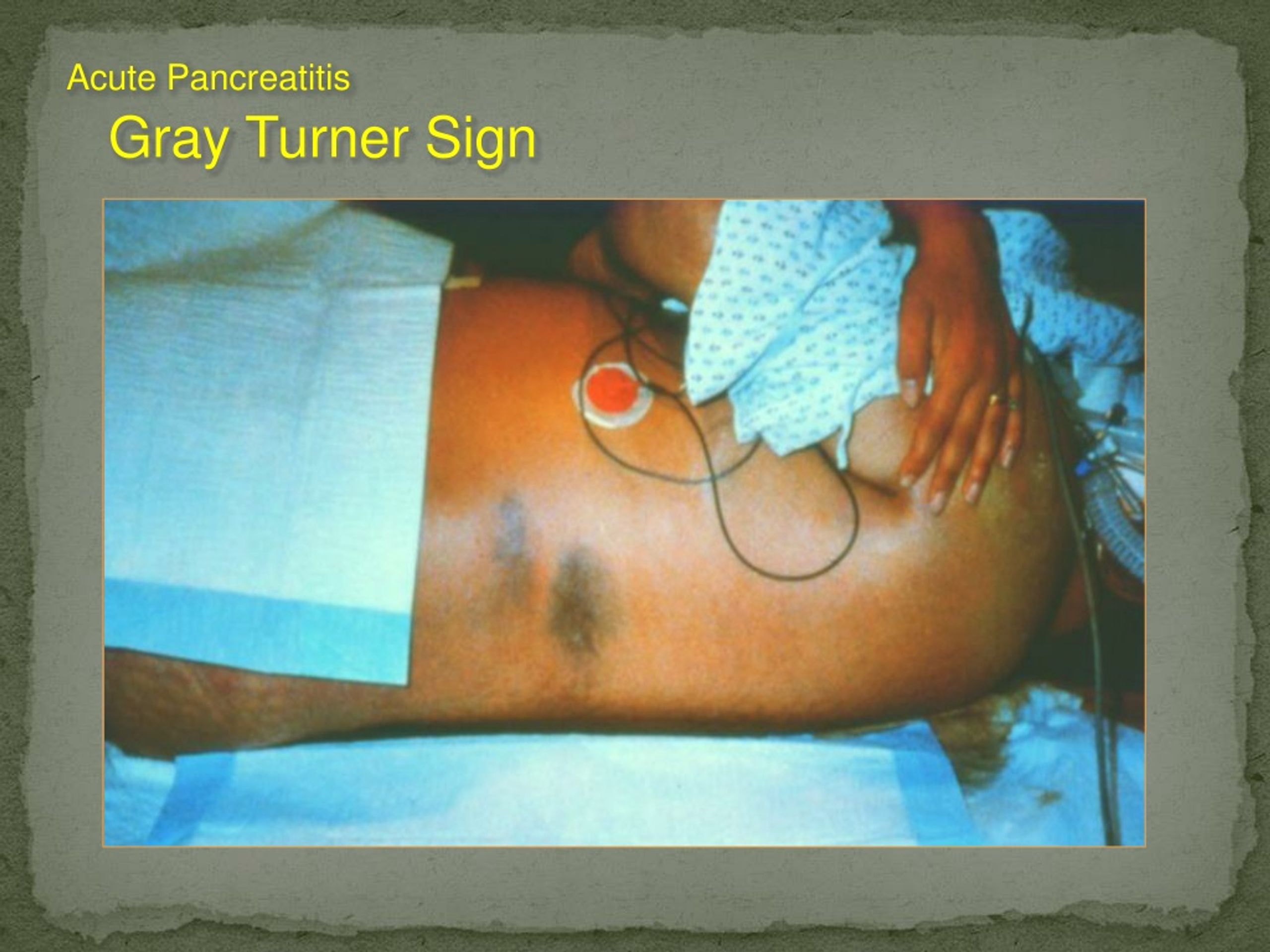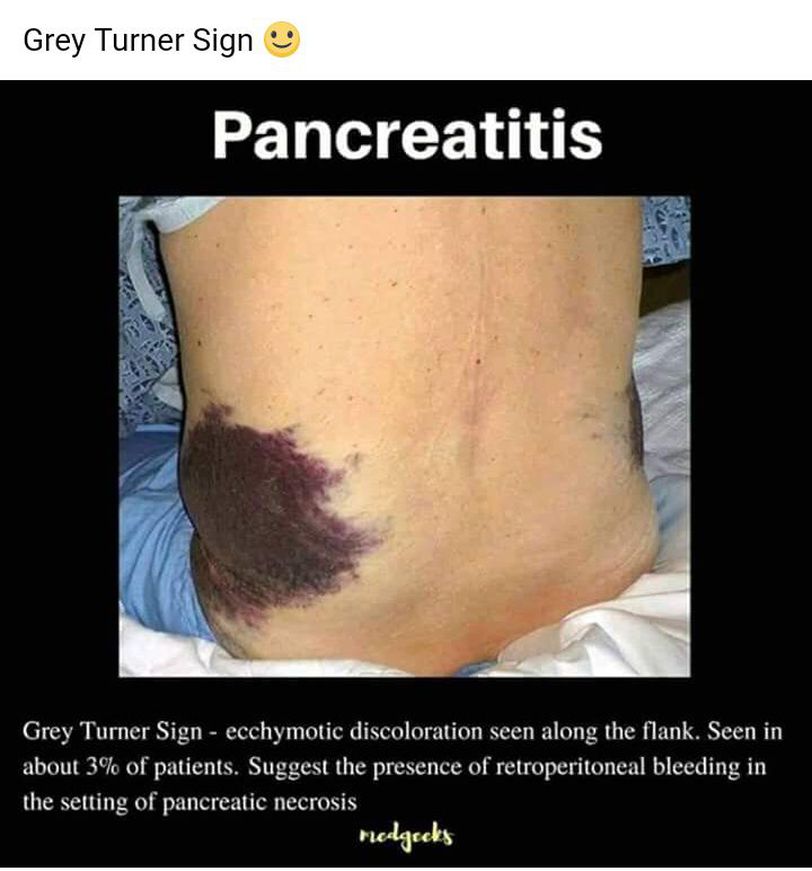ACUTE PANCREATITIS Signs, Symptoms, Causes YouTube

Turner's Sign Cullen's Sign Nursing mnemonics, Nursing school tips, Medical ultrasound
Grey Turner's sign is a well described butrarely seen sign usually indicating severe intra-abdominal pathology. Classically it is associated with severe acute pancreatitis but can beassociated with a number of other severe intra-abdominal conditions.

An unusual cause of Grey Turner's sign BMJ Case Reports
Grey Turner's sign refers to bruising of the flanks, the part of the body between the last rib and the top of the hip. The bruising appears as a blue discoloration, [1] and is a sign of retroperitoneal hemorrhage, or bleeding behind the peritoneum, which is a lining of the abdominal cavity.

(PDF) Grey Turner's sign in acute necrotizing pancreatitis
If you receive a telephone call from someone claiming to be an IRS employee and demanding money, you should consult the IRS Tax Scams/Consumer Alerts webpage. If you know you don't owe taxes or have no reason to believe that you do, report the incident to the Treasury Inspector General for Tax Administration (TIGTA) at 1.800.366.4484.

PPT Abdominal Trauma PowerPoint Presentation ID2275990
Grey Turner sign is characterized by the appearance of purplish-bluish skin discoloration (ecchymosis) on the flanks due to internal bleeding. The color of ecchymosis will vary depending on the extent of RBCs breakdown in the tissues of the abdominal wall. Ecchymosis may appear as a greenish, bluish, purplish, and yellowish,

Grey Turner Sign In Pancreatitis / Classically, it is associated with severe acute
Non-traumatic abdominal ecchymosis, in particular - bruising of the flanks associated with retroperitoneal haemorrhage, originally described in acute pancreatitis. 1920 - The English surgeon George Grey Turner (1877-1951) published paper on ' Local discoloration of the abdominal wall as a sign of acute pancreatitis ' citing two cases.

Images of Note Grey Turner and Cullen Signs Consult QD
- Grey Turner sign - Gallstone in gallbladder US - CT scan acute interstitial edematous pancreatitis - CT scan necrotizing pancreatitis - CT scan acute peripancreatic fluid collections - CT scan acute necrotic collection - CT scan infected pancreatic necrosis RELATED TOPICS. Patient education: Acute pancreatitis (Beyond the Basics) Acute calculous cholecystitis: Clinical features and diagnosis

Grey turner sign causes, pathophysiology, sign value YouTube
Grey Turner's sign is an uncommon subcutaneous manifestation of intra-abdominal pathology that manifests as ecchymosis or discoloration of the flanks. Classically it correlates with severe acute necrotizing pancreatitis, often in association with Cullen's sign (periumbilical ecchymosis).

Grey Turner's sign (Medical Symptom) YouTube
Cullen sign, first described in 1918, is superficial bruising in the subcutaneous fat around the umbilicus. 1 It has been described in acute pancreatitis, rectus sheath hematoma, splenic rupture, perforated ulcer, intra-abdominal cancer, and ruptured ectopic pregnancy, and as a complication of anticoagulation. 2 Grey Turner sign refers to ecchym.

ACUTE PANCREATITIS Signs, Symptoms, Causes YouTube
The Grey Turner sign refers to the clinical finding of atraumatic flank ecchymosis, which is occasionally associated with retroperitoneal hemorrhage, classically due to hemorrhagic pancreatitis 2.

GreyTurner’s sign following iatrogenic duodenal perforation BMJ Case Reports
Grey-Turner sign is a clinical finding characterized by the presence of ecchymosis or discoloration of the flanks, usually indicative of retroperitoneal hemorrhage or severe abdominal pathology. It is named after the physicians George Grey Turner and Ernest Turne, who first described this sign. This comprehensive article aims to provide a.

GREY TURNER'S SIGN DIFFERENCE BETWEEN GREY TURNER'S AND CULLEN'S SIGN YouTube
What is Grey Turner's sign? Grey Turner's sign a discoloration occurring around the flank region due to blood pooling. Blood accumulation can be due to internal or external injury such.

(PDF) Grey Turner’s sign in severe acute pancreatitis
Grey Turner's sign is an uncommon subcutaneous manifestation of intra-abdominal pathology that manifests as ecchymosis or discoloration of the flanks. [1] Classically it correlates with severe acute necrotizing pancreatitis, often in association with Cullen's sign (periumbilical ecchymosis).

PPT PANCREATITIS RICHARD L. MONES MD HARLEM HOSPITAL PowerPoint Presentation ID377089
Free Despite advancements in diagnostic tools, physical signs are still useful indicators for underlying diseases. The use of Grey Turner's sign as a bedside predictor of acute pancreatitis is still controversial among clinicians.

Figure 2 from Grey Turner's sign. Semantic Scholar
Grey-Turner's sign. Grey-Turner's sign is bruising of the flanks. It occurs in severe, acute pancreatitis due to subcutaneous tracking of inflammatory, peripancreatic exudate from the pancreatic area of the retroperitoneum. It is also seen in severe abdominal injury, e.g. road traffic accidents, and in ruptured abdominal aortic aneurysm.

Grey Turner Sign MEDizzy
Grey Turner's sign is a well described butrarely seen sign usually indicating severe intra‐abdominal pathology. Classically it is associated with severe acute pancreatitis but can beassociated with a number of other severe intra‐abdominal conditions.

Pin on Trauma
Grey Turner's sign refers to bruising of the flanks, the part of the body between the last rib and the top of the hip. The bruising appears as a blue discoloration, and is a sign of retroperitoneal hemorrhage, or bleeding behind the peritoneum, which is a lining of the abdominal cavity.